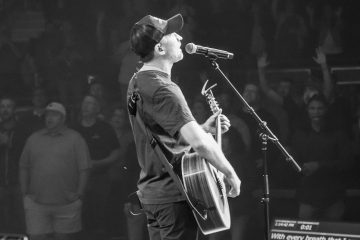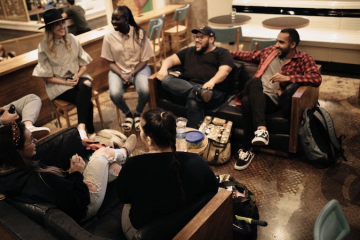How To Run Loops While Leading Worship

There are many ways that you can run loops in a worship setting but I want to take a moment and explain a few methods that I have used and the different ways you can use those methods. This will hopefully give a better understanding on how you can use loops no matter what experience or knowledge you have.
Triggering Loops With an iPad or iPod
The first method I would say would be having the worship leader or someone else in the band trigger the loop with an iPad or iPod. You can simply play the loop straight from iTunes or use an app such as touch osc (http://www.youtube.com/watch?v=gF7vMp_xuXY) that allows you to MIDI map to Ableton Live. To run loops this method all you will need is a stereo out cable running into a stereo direct box from your computer, iPad or iPod. This is probably one of the most affordable and easiest ways to start using loops in worship – and everyone needs to start somewhere. I started using my iPod to trigger my loops and I gradually moved up from there. One thing to note about this method is you don’t need a ton of money to start using loops in your worship gathering. You just need to start small and try it out.
Triggering Loops With a Controller
A second method to running loops in your worship experience would be to use a program such as Ableton Live with a MIDI controller. This method consists of having a MIDI keyboard, or a foot controller like the aBility controller or Soft Step controller. You can use these MIDI controllers to trigger your loop through Ableton. This method of triggering loops can get a bit more complex but in the long run it helps create excellence in your worship experience. I use this method each time I lead. There is a small learning curve. Getting to a point of proficiency in this method takes some knowledge and time to make sure it is implemented with consistency. As the worship leader, you need to be sure you understand how Ableton works and how your controller is configured / how to MIDI map your controller to Ableton. Do everyone in your band a favor and know what you’re doing before you just jump into it. It will help the whole band unite together when tension might be high during a rehearsal. You don’t want to be wasting valuable soundcheck and rehearsal time fidgeting with your loop set up. Be prepared and ready to go. But also be knowledgable about the equipment so that when/if a problem arises, you can fix it on the fly.
Triggering Full Tracks or Triggering Individual Parts
Full Tracks
Triggering a full loop track with or without a vocal cue can be a very easy and convenient way to start using loops. A full loop track gives great stability to the arrangement you are composing, but also is problematic if you get off the arrangement and you have to kill the loop. Having to kill the loop mid-song can totally de-rail a song and really pull away from the worship experience. Keep this in mind when you are in rehearsal. If your band does not have the song down with the loop during your rehearsal, you should NOT try to run with it during the worship experience (no matter how cool your loop is). Using a full loop track can give a great creative element when you use it with a video background or typography. I recently did this with a video background for “In Christ Alone” that we got from Igniter media and replaced the media with my own loop. This can be a little complicated, but if you want to look into it more you can also trigger Video within Ableton.
Triggering individual parts of the song.
Another way to use a loop in worship experience is triggering each individual part of a song. If you have your loop broken up into different parts of the song, you have the freedom to control where the song is going. If the band gets off the loop you can kill it and then bring it back in at the next part. Triggering each individual part can also be helpful when you have a song that doesn’t need a loop the whole time. Maybe you just want to trigger a tambourine or a shaker for certain parts. I use to do this a lot but now I am finding my self using a full track more often because my arrangements are already set before rehearsal time. If I need to make changes to the loop, I can do so before the weekend. You can also set up Ableton to run a full track and also have it mapped out to trigger different parts. You can do this using “Locators” in arrangement view. This gives the freedom to go back to a part of the song or if you had to kill the loop you can trigger the next part of the song.
Hopefully these thoughts are helpful. If you have any question please leave a comment and continue the conversation.




14 Comments
Ryan · November 17, 2011 at 12:18 am
Jake,
Appreciate the tutorial. Really like the backing pad concept. Mind going into more detail on how you’ve created/assigned that? Do you transpose it weekly to match the transition in the set?
I could see it as a super helpful transition tool.
Thanks for the input.
Jake · November 19, 2011 at 9:03 pm
I’m glad u enjoyed the post. It’s actually pretty simple on how I’m doing this. So I’m taking a swelling synth sound or guitar swell mp3 that is repeating like 7min in the key of the song we are in and having it always running in ableton when the click is on. Then you can assign a fader or in my case my expression pedal to volume up or down as needed. Most cases Im using it to transition to a song in the same key, But I could set it to trigger a different pad and volume down and volume in the new one. Just wondering if you have tried anything similar to this before? Thanks for the comment.
Roger · November 21, 2011 at 11:09 am
So sweet man. Great post.
Matt McCoy · November 22, 2011 at 12:49 am
absolutely LOVE the idea of bringing in a pad when needed. I’d like to explore this in utilizing a MIDI instrument instead of an MP3. It would also be interesting to utilize a SoftStep foot controller to trigger different keys of a pad… thoughts on how to implement this in Ableton?
Pablo Martinez · December 1, 2011 at 9:01 am
Hey man I have a question. So I’ve been using an mp3 playing out of my tablet connected to a splitter cable into 2 direct boxes. Now I wanna run it from my mac. The only problem is that when I use the same cable it doesn’t pan even though it is panned in the software(Reason).. I’ve tried this several times and decided that I’ll try getting the panning out of the audio interface. My options are “M-Audio MobilePre” and the “Focusrite – Scarlett 2i2”. Btw my mac doesn’t have firewire. What would you recommend ?
Ben Worcester · December 5, 2011 at 7:01 pm
This weekend, I was conducting our orchestra and triggering the loops. I used the Mobile Mouse app for iPhone to trigger the space bar in Reason on the loop computer (positioned on the piano). To switch to the next loop, I used command-w to close the window and space bar to start the next song. I simply put my phone on a stand next to me and triggered them from front and center.
Jake Stemo · December 6, 2011 at 2:08 pm
Pablo
Thanks for the questions. Sometimes the mp3 is not split correctly and you are getting bleed into the other channel because that’s how the audio was bounced. Always go back to the source first then follow it from there to figure out the problem.
Between the two interface, I have not used either of these interfaces but they both seem to have similar features. The Mobile Pre has more inputs which gives a little more versatility but once again they are both about the same price. In my personal opinion I would check out the Presonus audioBox which has the same In/Outs as the 2i2 but it also gives a huge advantage with a midi In/Out so you could connect a keyboard or controller through it and this interface is usb. check it out in the hardware section of Loopcommunity.com.
Hope this helps out.
Jake Stemo
Jake Stemo · December 11, 2011 at 8:21 pm
Ben
That sounds pretty awesome I haven’t used the Mobile Mouse app but I have messed around with the touch osc app a little bit. Just wondering if you have had any connection problems with the app or how far away you where from your computer? Kinda off topic but I would love to hear how your orchestra likes playing with your loops? How long have you been using loops with them? thanks for the comment.
Jake Stemo · December 11, 2011 at 8:34 pm
Matt
I was thinking about what you posted and I think you might be able to do this with the Max instrument in ableton assigning your softstep controller to the desired chords but I have not explored this yet. If anyone has I would love to hear how its working for you. Another way you would be able to do this pretty smoothly is with the 12 step controller http://www.keithmcmillen.com/12step/overview . Having the ability to play five notes per key sounds pretty awesome for different key changes between songs.
Tonya · January 28, 2012 at 9:01 am
hi!I’ve always been confused by the term “bank” when it comes to MIDI controllers. Could you expand on this in relationship to what you covered in the video… in other words, what are the bank changes doing and why are you changing them for your worship set? I think I have an idea, but just checking.
thanks!
Matt McCoy · January 31, 2012 at 4:50 pm
Tonya, think of a bank as an individual song… and then each song has 6 different parts. So on the aBility controller, Bank 1 is song 1 – with 6 loops. Bank 2 is song 2 – with 6 loops. There are 127 notes available in MIDI, and because controllers don’t have 127 buttons on them, they need to be divided up into smaller portions – banks.
brandon · February 17, 2012 at 11:05 am
I have a question, how do I setup my softstep to be like that of the ability controller? Is there anywhere online that shows how ? I noticed you are selling the patch you created however I don’t have $10 to spend on a patch so any help would be great do I can use this pedal this weekend! 🙂 BTW I love this site and the loops! I use them a lot. Great job! 🙂
Mitch Beauman · August 31, 2012 at 5:18 pm
Jake,
How do you set your volume pedal up through the Ability Controller and set its parameters in Ableton to control loop volume? I’ve had some issues trying this. Thanks man.
Jake Stemo · September 2, 2012 at 3:20 pm
Hey Mitch
I have 2 extra expression outputs on my ability controller. I plug my 1/4 from my volume pedal into the ability expression 1/4 plug witch allows me to midi assign it to whatever I want. Then I map it to control the pad sound channel I have in ableton. Some volume pedals do not work with the ability. Fc7 works great.